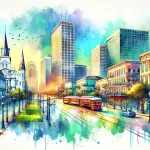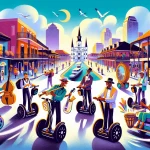New Orleans, a city celebrated for its distinctive spirit and cultural diversity, hosts an extraordinary collection of religious museums that showcase the interplay between faith and artistic expression. From the grandeur of historic cathedrals to intimate galleries, these institutions offer a profound exploration of the city’s spiritual roots and the artistic manifestations that have emerged from them.
In This Article
TL;DR
- New Orleans’ religious museums exhibit a unique blend of faith and artistic expression, reflecting the city’s diverse cultural influences.
- These museums play a vital role in preserving religious heritage and promoting understanding across different belief systems.
- Visitors can explore a wide range of collections, from ancient artifacts to contemporary artworks, each offering insights into the significance of religious art.
Historical Context of Religious Museums in New Orleans
The origins of New Orleans‘ religious museums can be traced back to the city’s founding by French colonists in the early 18th century. As Catholicism took root, churches and religious orders began amassing collections of sacred art and artifacts, laying the foundation for what would become some of the city’s most revered museums.
The influence of New Orleans’ diverse cultural and religious backgrounds, including French, Spanish, African, and Native American traditions, has left an indelible mark on these museums. Key historical figures, such as Mother Henriette Delille, a free woman of color who founded the Sisters of the Holy Family, and Père Antoine, a Capuchin friar known for his humanitarian efforts, played pivotal roles in shaping the religious museum landscape.
Exploration of Major Religious Museums in New Orleans
New Orleans Museum of Biblical Art
Located in the city’s core, the New Orleans Museum of Biblical Art is a true treasure for those seeking to explore the intersection of faith and artistic expression. Its collection spans centuries, featuring ancient manuscripts, intricate sculptures, and captivating paintings that depict scenes from the Bible and religious traditions.
One of the museum’s most iconic pieces is the “St. John’s Bible,” a breathtaking contemporary illuminated manuscript created by renowned calligrapher Donald Jackson. This masterpiece, commissioned by St. John’s University in Minnesota, is a testament to the enduring power of sacred texts and the artistry that brings them to life.
The Historic New Orleans Collection
The Historic New Orleans Collection is a treasure trove of artifacts and artworks that shed light on the city’s rich religious heritage. Among its prized possessions are intricate altarpieces, ornate vestments, and rare manuscripts that offer glimpses into the spiritual practices of New Orleans’ diverse communities.
One of the collection’s most captivating exhibits is the “Voodoo in New Orleans” display, which explores the complex history and cultural significance of this often misunderstood belief system. Through a thoughtful curation of artifacts and historical accounts, visitors gain a deeper understanding of the role Voodoo has played in shaping the city’s cultural identity.
Architectural Significance of Religious Museums
The architectural styles of New Orleans’ religious museums are as diverse as the faiths they represent. From the soaring Gothic arches of St. Louis Cathedral to the ornate Baroque details of the Ursuline Convent, these structures are not merely buildings but sacred spaces that inspire awe and reverence.
The architects who designed these museums, such as James Gallier Sr. and Benjamin Henry Latrobe, were masters of their craft, imbuing each structure with symbolic elements that reflect the spiritual beliefs they were built to honor. The intricate stained glass windows, towering spires, and intricate carvings serve as visual narratives, inviting visitors to embark on a journey of spiritual discovery.
Educational Programs and Community Engagement
New Orleans’ religious museums are not merely repositories of art and artifacts; they are living institutions dedicated to fostering education and community engagement. Many of these museums offer a wide range of educational programs, from guided tours and lectures to workshops and interactive exhibits, designed to deepen visitors’ understanding of religious traditions and their artistic expressions.
These programs have a profound impact on community awareness and religious tolerance, fostering dialogue and understanding across diverse belief systems. Partnerships with local schools, religious institutions, and cultural organizations ensure that the museums’ educational initiatives reach a wide audience, inspiring curiosity and appreciation for the city’s rich spiritual heritage.
Visitor Experience and Accessibility
New Orleans’ religious museums prioritize creating an inclusive and accessible experience for all visitors. From wheelchair-friendly entrances and audio guides to braille signage and sensory-friendly exhibits, these institutions strive to ensure that everyone can engage with and appreciate the collections on display.
To fully immerse themselves in the religious context, visitors are encouraged to engage with the exhibits through guided tours, interactive displays, and multimedia presentations. These immersive experiences not only provide historical and cultural context but also foster a deeper emotional connection with the artworks and artifacts on display.
Role of Technology in Enhancing Museum Experience
In the ever-evolving world of museum curation, New Orleans’ religious institutions have embraced technology as a powerful tool to enhance visitor experiences. Interactive displays, virtual tours, and multimedia presentations bring the collections to life, offering a multisensory journey through the city’s spiritual heritage.
Technology also plays a crucial role in preserving delicate artifacts and providing detailed insights into their significance. High-resolution imaging and 3D modeling techniques allow visitors to examine intricate details and gain a deeper appreciation for the craftsmanship and symbolism behind each piece.
Preservation Efforts and Future Challenges
While New Orleans’ religious museums are dedicated to preserving the city’s spiritual legacy, they face significant challenges in terms of preservation and funding. Environmental factors, such as humidity and natural disasters, pose threats to the integrity of the collections, requiring constant vigilance and innovative conservation strategies.
To overcome these challenges, the museums employ state-of-the-art preservation techniques and collaborate with local and international organizations to secure funding and resources. The role of local government and international bodies in supporting these cultural institutions is crucial, ensuring that the city’s religious heritage remains accessible to future generations.
New Orleans’ religious museums offer a captivating journey through faith and art, inviting visitors to explore the diverse spiritual traditions that have shaped the city’s cultural identity. From ancient artifacts to contemporary masterpieces, these institutions serve as guardians of sacred stories, preserving the artistic expressions that have transcended time and inspired generations of believers and admirers alike.






